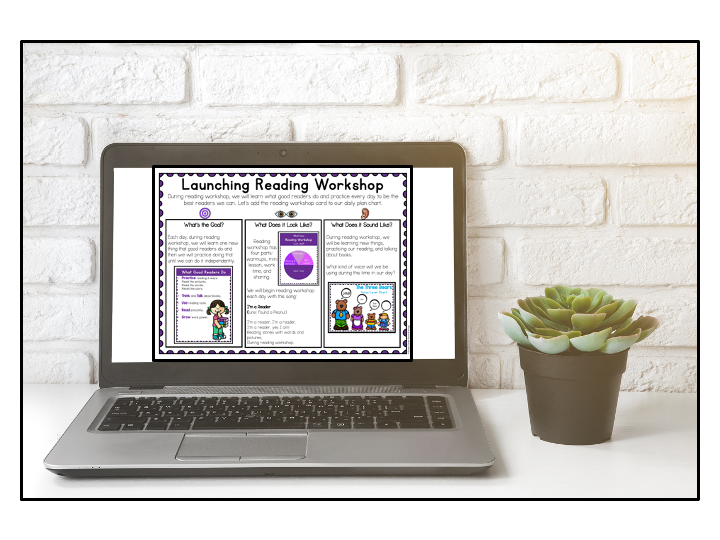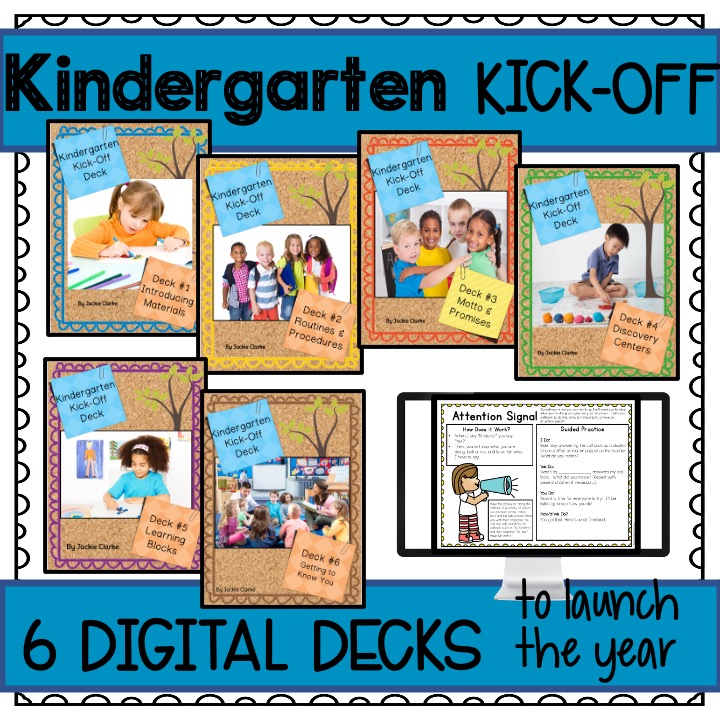Moving Too Fast on Those First Days of Kindergarten
“Mrs. Clarke, what’s math?”
We are in those first days of kindergarten, and this is what I hear. I’ve just told children that we are going to do math. I’m surrounded by socks and sorting circles and wondering how the heck I am going to answer this.

I realize that in my efforts to get this “kindergarten train” rolling, I may have forgotten something.
It never occurred to me that maybe our first lesson should have been about the “big idea,” of math (leave it to Kinders to always let you know what you need to do).
This is how I came to develop a 3-Step launch plan for each learning block that begins with a slow start, but actually sets us up for an entire year of learning.
To avoid your own kindergarten train “derailment,” follow these steps during those first days in kindergarten.
My 3-Step Launch
Step 1: What is the Kindergarten Goal?
Let children know where the train is headed before they get on board.
Teach children about your goal/purpose for each part of your day and create charts of those goals. I list mine in a What Good Readers Do, What Good Writers Do, What Good Math Thinkers Do, etc. format and turn each goal into a teaching point that I draw from for mini lessons all year long.

Using this language does two things – it helps children recognize the big goal (to become a good reader, writer, etc.) while also outlining the steps they need to take to get there.
Step 2: What Does it Look Like in Kindergarten?
Just as a train is broken down into many cars, each learning block has many parts (i.e. warm-ups, mini-lesson, work time, etc.)
Help children see the internal structure inside each learning block that is not visible on your daily schedule. Help them picture it using a graphic, such as a pie chart, that easily illustrates the break down. Using the same internal structure, such as with a workshop approach, across many subject areas, makes it easier for children to grasp as the expectations will be consistent.

Model and role play what happens during each segment of the learning block and provide time for children to practice and reflect on what they are experiencing. Ask them to share how each part helps them to be a better reader, writer, etc.
Step 3: What Does it Sound Like in Kindergarten?
You wouldn’t use the same voice inside the snack bar as you would inside the sleeping car!
Each learning block requires different voice levels. I use The Three Bears to help my Kinders understand the difference between voices that are loud, soft, and just right.

Following a reading of the book, I give children phrases to practice saying in each voice such as “hello,” “good morning,” or “What’s for lunch?” As you launch each learning block, return to the Three Bears and identify which “bear voice” is the one that you might use during that time of your day. Point out that Goldilocks voice is a “silent” one, as in most versions she does not speak. Discuss the appropriate times for them to use their “Goldilocks voice,” such as a fire or emergency drill.
Making a Trial Run
Once your Kinders know the goals behind each learning block and can picture what it looks and sounds like, it’s time for you to embark on a trial run. Keep the content light in order to focus on the structure and voice levels. A good place to start is introducing and exploring materials on those first days of kindergarten.
Continue to reinforce all that they’ve learned during the launch by starting each block with reminders. Ask, “What are our reading goals?” “What does reading workshop look like?” and “What does reading workshop sound like?” Provide them with feedback on how they are doing by asking, “What is working well?” and “What is not working well?”
Staying on Track Beyond Those First Days of Kindergarten
Just because you’ve moved past those first days of kindergarten, doesn’t mean you should forget all about what you taught during the launch period. Return to your charts throughout the year to keep both you, and your kiddos, on track.
And resist the urge to break out those socks and sorting circles too soon! Start with an intentional launch plan and you’ll be chugging along in no time!
The Learning Blocks Kick-Off Deck
Find more ideas on launching each learning block, along with schedule cards and teaching posters in Kindergarten Kick-Off Deck #5 – Learning Blocks, which is now available in a digital version.

This is just one 6 Kindergarten Kick-Off Decks that I use to launch my first days and weeks in kindergarten.

For more on building a kindergarten day, check out the Growing a Daily Rhythm page in the Roots & Wings Resource Library.


 Fall Inquiries and Research Groups in Kindergarten
Fall Inquiries and Research Groups in Kindergarten Launching Choice Time Centers at the Beginning of the Year
Launching Choice Time Centers at the Beginning of the Year Kindergarten Name Writing: The Missing Steps
Kindergarten Name Writing: The Missing Steps The Pumpkin Project
The Pumpkin Project
You have some great practical ideas here. All the best for your teaching year!
I love how you broke the workshop down into the different parts. We're starting guided math this year in third grade. That's kind of what our schedule is going to look like – a minilesson, small group lessons with the teacher and centers, and reflection at the end. Hoping it works well!